People
The Legacy of Mike Rama
“I’ve been preparing to be a leader all my life.” — Mike Rama


It is definitely not a statement that just anyone can throw around. Then again, if you are the incumbent mayor of a progressive city like Cebu, there is sure to be a lot of grit anchoring it. Mayor Michael “Mike” Rama has had nineteen astounding years in public service, but after winning the 2010 elections for the esteemed post, he has never been more motivated, or been busier.
It took some prodding on our part before we could finally squeeze into the city manager’s hectic schedule for a midday photo shoot with his son, Mikel. We were to have approximately two hours with him before his next appointment. Since our location was off the main road, we offered to meet Mayor Rama at a nearby landmark and form a convoy.

A maroon pick-up with the “MAYOR” license plate arrived, a Philippine flag mounted on its hood. As we “escorted” the mayor, we couldn’t help but notice other vehicles giving way without a moment’s hesitation. There could not have been a more distorted prelude to our discovery of just how down-to-earth Mayor Rama actually was.
He came in a white, button-down, short-sleeved shirt and denim trousers, and his raspy voice immediately filled the studio as he greeted everyone; his presence was anything but intimidating.
Mayor Rama beamed a smile of surprise when he caught sight of Mikel dappered up in a suit. “I didn’t know we were doing the shoot together!” he told kidded. The father and his twenty-five-year-old son now live in separate houses but make it a point to see each other at least once a week despite the former’s demanding daily itinerary. “He calls me all the time throughout the day,” Mikel shared.
The same goes for his daughter, Micheline, a fine arts graduate from the University of the Philippines (UP)-Diliman, whom Mayor Rama stays in close contact with. Having served as a creative consultant for various advocacies and NGOs in Manila, she is currently the publicity head and a member of the board of directors of Dakila, a group of artists, writers, students, and other individuals promoting social awareness and involvement.
“That’s the advantage of having a small family,” Mayor Rama said. “We can give each child more undivided attention.”
Quite the contrary, however, Mayor Rama has come from a family that is not exactly small. He grew up with twelve other siblings at their compound in Barangay San Nicolas in Cebu.
But theirs is a lineage entrenched in the political arena. His grandfather, the late Don Vicente Rama, whom he refers to as “the old man,” was a Cebu City councilor, and was mayor, congressman, and senator besides. His uncle, Osmundo Rama, is a former governor of Cebu Province, and his brother, Eduardo L. Rama, Sr., the former governor and congressman of Agusan del Norte.
Numerous as these influences are, it was from his father, the late Fernando Rama, a former Cebu City councilor, that Mayor Rama acquired a most important trait:
“I learned about the value of hard work from my dad,” the mayor said. “We used to work for our poultry business in the morning—selling eggs and doing chores—before we would attend school in the afternoon. In a way, you can say that at a young age, we were already helping others,” he joked.
“I was the inquisitive son. I was young but I liked to interact with old people and observe what was happening around me.” Rama as a boy clearly showed potential in following the footsteps of his politically prominent relatives—he was a cub scout, the valedictorian of his high school batch at the University of Southern Philippines and responsible son and brother. “My four sisters were not allowed to go on dates by themselves so I would chaperone for each of them. Helping out became natural to me. It’s just automatic.”
Mike Rama took a pre-medicine course at Velez College in Cebu, but then proceeded to Manila to finish a law degree at San Beda College. With determination, he passed the bar exam in 1983.
He started in public service as a Cebu City councilor in 1992. He successfully served three consecutive terms, during which he was appointed chairman of the Area Vocational Rehabilitation Center II Advisory Council, and was duly recognized by colleagues as he gained the title of National President of the Philippine Councilors League (PCL).
It seemed only inevitable that he would land the major municipal post of vice mayor in June 2001 and would hold it for the next nine years. He was appointed chairman of several government and non-government agencies, most notably the Zoning Board of Cebu City, the Cebu City Tourism Commission, the Police Coordinating and Advisory Council (PCAC), and the People’s Law Enforcement Board (PLEB). He was also elected as the president of the Vice Mayors League of the Philippines (VLMP). During his three terms, his trademark projects—the annual Sinulog Festival, Pasko sa V. Rama, and the revitalization of Colon in downtown Cebu earned him votes of appreciation from fellow Cebuanos, so that when he ran for the coveted post of Cebu City mayor in 2010, he won by a wide margin.

Said Mayor Rama, “Many would not like to be in politics, some of them even wondering how I have been able to survive amidst many challenges. I told them I’m very clear with my purpose in government; I’m taking it as a vocation. Therefore, public service for me is a means of mortification and giving hope that there is still a career in it. I want the youth to regain hope and to trust the government.”
His campaign slogan during the last election was, “Together we make things happen.” It has given way to an inverted-pyramid style of management wherein, according to Mayor Rama, “everyone is a participant. Rather than me directing or imposing, we start on the same plane and implement together. It’s the people who are the force.” The development framework he has introduced envisions beautiful coastal barangays, a revitalized downtown, a progressive uptown, and upland development balanced with environment conservation.
And what does he have to say about his detractors, the most recent ones arising from his controversial separation from his long-time political party, BO-PK?
“I try to look at the bigger picture,” Mayor Rama said. “I want to leave a legacy—that when I became mayor, I did what I was supposed to do. What matters is making Cebu a sustainable community.”
Rama shows his dedication to the cause by exhausting his daily schedule. He said, “I wake up as early as 5:30 in the morning. If I will not do that, I won’t have enough time to interact with people. I make sure to go through the documents to be signed because there is never a good reason for the government to be delayed.” Chuckling, he continued, “And then I go through a bond paper sheet’s worth of activities.”
Though his eight-hour shifts often extend to twelve hours, the mayor never seems to run out of gusto. “I love it!” he told us. “The passion to serve is in my system.”

This commitment we were delighted to see as he stepped in front of the camera and internalized a character for each pose, to the point of creating scenarios and a dialogue around them.
“Every moment should be injected with seriousness,” Mayor Rama said.
He kept us entertained by an impressive repertoire of expressions (think Barrack Obama meets Donald Trump) with matching hand gestures, and had Mikel and the rest of us laughing as he verbalized lines like “Oh, come on!” or “You want a piece of me?” He even sang a few verses of The Way You Look Tonight, which was one of two songs he performed for a recent event. The other was the Visayan classic, Usahay.
Mikel recalled his fondest childhood memory with his father: “My dad used to read bedtime stories to me and my sister. He loves to sing and really likes speaking. Whenever he reached the end of the book and didn’t want to stop talking yet, he would sing the titles of the other books mentioned in the publication’s credits. Even up to now, I can still remember the sequence of those book titles and the way he sang it. It was so funny!”
This being their first photo shoot together, the mayor helped his son loosen up by reeling him in on his spiels and offering actual advice about life and love as they walked together on the cemented path beside the studio. Described by Rama as “a very obedient son,” Mikel had gone to Sacred Heart School-Jesuit, now Ateneo de Cebu, and obtained a law degree after finishing his undergraduate studies, just like his dad, at the University of San Carlos.
Mikel shared with us his father’s reaction to his passing the bar exam last March: “He was really happy. I only remembered seeing my dad cry once, and that was when my grandfather died when I was still a kid. But then I saw him do it again during our thanksgiving dinner. He’s usually very talkative but when he was asked to give a toast, he was speechless and in tears. It really meant a lot to him.”
The young lawyer took his oath in April and started working in mid-June for an established Cebu-based law firm. Seeing as how his career path seems like history repeating itself, we wanted to know if Mikel could see himself entering politics as well.
“For now,” he replied, “I have no immediate plans and want to practice law first. Being in public service is a responsibility and it isn’t easy. You need to gain enough knowledge, be committed, and be ready for it. Politics has been in our family for a long time and we have built a reputation, so you can say that I am predisposed to it. It’s a calling and if I were to be called, it would be an honor.”

Embarking on his first job, Mikel would like to emulate qualities he admires in his father: “My dad doesn’t seem to have a tough exterior but he’s really disciplined. He’s been through a lot. It seems like nothing fazes him. You can never see him worried. He controls his emotions very well. And he never gets tired. His dedication…it’s the opposite of lazy. That’s what I want to achieve.”
But for the honorable Mike Rama, it is only a matter of time before a person develops his full potential as long as the intent to learn is there, just as it has always been for him: “Growing and learning are two different things. You can grow in age but it doesn’t mean that you are wiser. The desire to learn should never be lost. One must do things with significance.”
From a father who somehow always knew what he wanted from the get-go, to a son who just might find his way down the same road, the future of Cebu continues to hold strong promise.
by Pia Echevarria sittings editor Katsy Borromeo editorial assistant Kurt Jarabilo grooming Romero Vergara grooming assistant Jessie Egos photography Dan Ong
People
A Destination Wedding in Capiz; A Love Story in Focus

by Oj Hofer | photography by Pat Dy | styling by Romero Vergara | bridal gown & groom’s tuxedo by Oj Hofer
As June draws to a close—a month filled with vows, veils, and wedding bliss—it’s only fitting to end with a love story that began not in a chapel, but behind the lens of a camera. Meet the groom, Phillip Novo: a seasoned maritime officer commanding international vessels by profession, and a passionate hobbyist photographer in his downtime. Mr. Novo has captured countless scenes from around the world, but nothing compares to his candid portraiture study of the woman he would soon marry—Mitch Alianza—in a heartfelt ceremony at the Sacred Heart of Jesus in Roxas City, Capiz.

Philip keeps it classic in sun-washed Seychelles beige linen.

Mitch channels Persephone in a gown that blossoms with spring’s charm
Capiz became the couple’s destination of choice as an homage to the bride, who hails from the province. Historically, Capiz was the second Spanish settlement established in the Philippines. With its 80-kilometer coastline and a mesmerizing stretch of rivers and swamplands, the province offered a natural allure to the wedding party. Yet for the groom, it was more than scenery—it was about honoring his bride’s heritage and heart.
Their love story spans continents, email inboxes, and a few overpacked pieces of luggage. Phillip recalls their serendipitous encounter involving jumpsuits, hot air balloons, and the rhythm of a life lived in sync.

The Sacred Heart Shrine in Capiz, transformed into a lush tropical dreamscape.
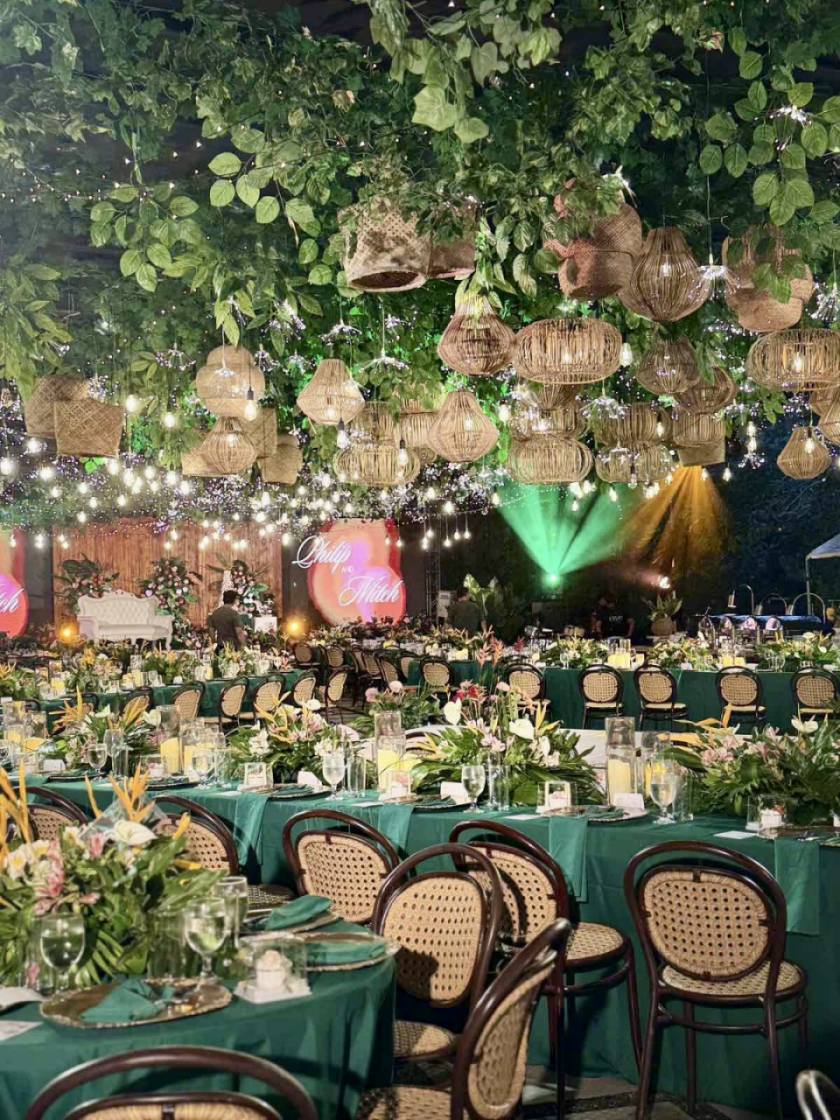
Wicker baskets, solihiya chairs, and cascading greens brought understated elegance to the naturalistic reception at Istorya Forest Garden.
How did you meet Mitch?
Right after covering a friend’s wedding. I spotted her navigating the space with this quiet confidence. We didn’t even speak—just exchanged a look. Later came a few messages, a first date, and her walking toward me in a black jumpsuit. That moment? Unforgettable. I thought, “Ka-Vogue!”
When did you know she was the one?
Honestly, from the start. I had just closed a big chapter of my life—career goals, family responsibilities—and when I held her hand for the first time, I didn’t want to let go. Everything just aligned.
You proposed in Turkey—why there?
Cappadocia. Picture it: fairy chimneys, floating hot air balloons, and this surreal landscape. It felt like a dream, and in that dream, I asked her to marry me.
Who plans your trips—beach bum or mountain guy?
I map out the adventures, and Mitch plans what we wear on them. She packs only what fits and flatters—and trust me, she always looks like she stepped out of a fashion editorial. Our luggage deserves its own Instagram.
If you had 10,000 lives, would you marry her each time?
Every single time. Even if we met in another galaxy.
What’s one quirky thing you love about her?
She’s endlessly resourceful. Whether it’s an outfit or a life goal, Mitch can pull it together like no one else. She’s sharp, creative, and once she sets her mind on something, there’s no stopping her.
What’s your message to Mitch as you set off on this next big adventure together?
Hi, Love—keep holding my hand. No matter how the winds blow, let’s keep making memories, telling stories, and seeing the world—together.

A Sky Full of Balloons, a Heart Full of Yes — Philip Proposes to Mitch in Magical Cappadocia
People
The Cardinals–an Amazing Gallery of Portraits on Cardinals in the Philippines by Artist Jun Impas

by Jing Ramos
With the recent death of Pope Francis on April 21, the Catholic Church is now focused on the election of the new Pontiff. The succeeding Pope will be challenged with continuing Pope Francis’ appointments and reforms, which leaned heavily on social justice and environmental issues.
According to the Code of Canon Law, the two most important functions of a Cardinal are to advise the Pope on matters of Church governance and global issues, and most importantly, to assume a vital role in electing a new Pope when the Holy See (Sede Vacante) is vacant.
In 6th-century Rome, the first individuals known as Cardinals were the deacons of the seven regions of the city. Since then, Cardinals have become a privileged group among the Roman clergy. It wasn’t until the 11th century that Cardinals were officially granted the right to elect a Pope. They were given the honor of wearing a red hat, which soon became their symbol. Often referred to as “Princes of the Church,” Cardinals wear distinctive red attire and are addressed as “Eminence,” a title that conveys dignity and respect.
Currently, one of the most favored contenders to continue Pope Francis’ progressive agenda is Cardinal Luis Tagle. He brings significant experience as the Pro-Prefect for the Section of the First Dicastery. Also serving as President of the Interdicasterial Commission for Consecrated Religious, Cardinal Tagle is the Grand Chancellor of the Pontifical Urbaniana University. Beyond his titles, he is widely known in the Vatican as a trusted figure within Pope Francis’ core group.

Cardinal Luis Tagle and artist Jun Impas
Jun Impas, a highly respected Cebuano visual artist known for his realistic paintings, shares his gallery of Filipino Cardinals. The artist’s accurate and detailed depictions capture not only the physical likeness but also the presence of his subjects. “As a realistic painter, my works revolve around human figures, religion, significant cultural events, and quintessential Filipino scenes. I believe in the beauty of the ordinary, and that the most touching and telling of any story is better felt when captured in infinite duration, as in a realism painting,” the artist concludes.
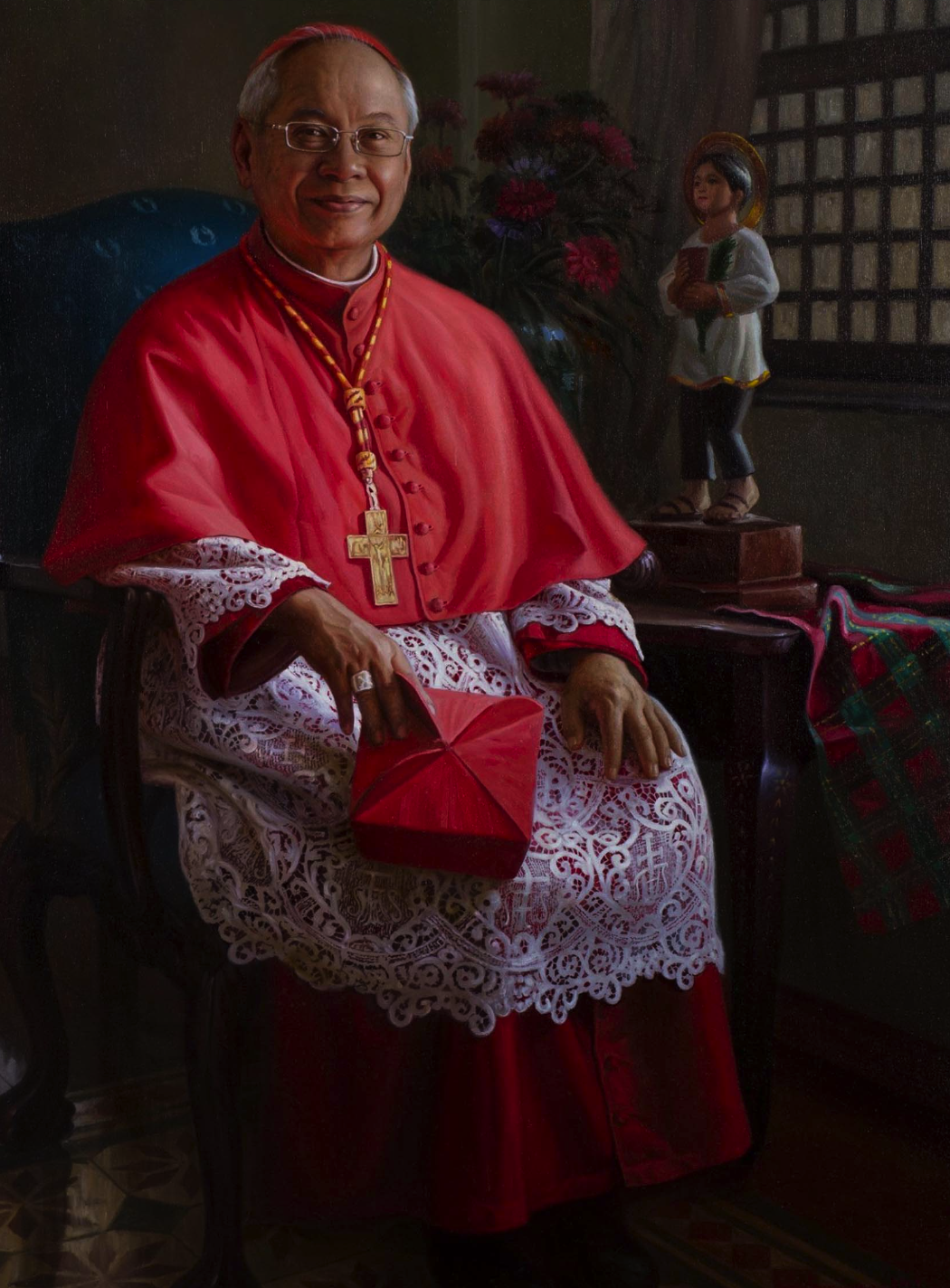
Cardinal Orlando Quevedo
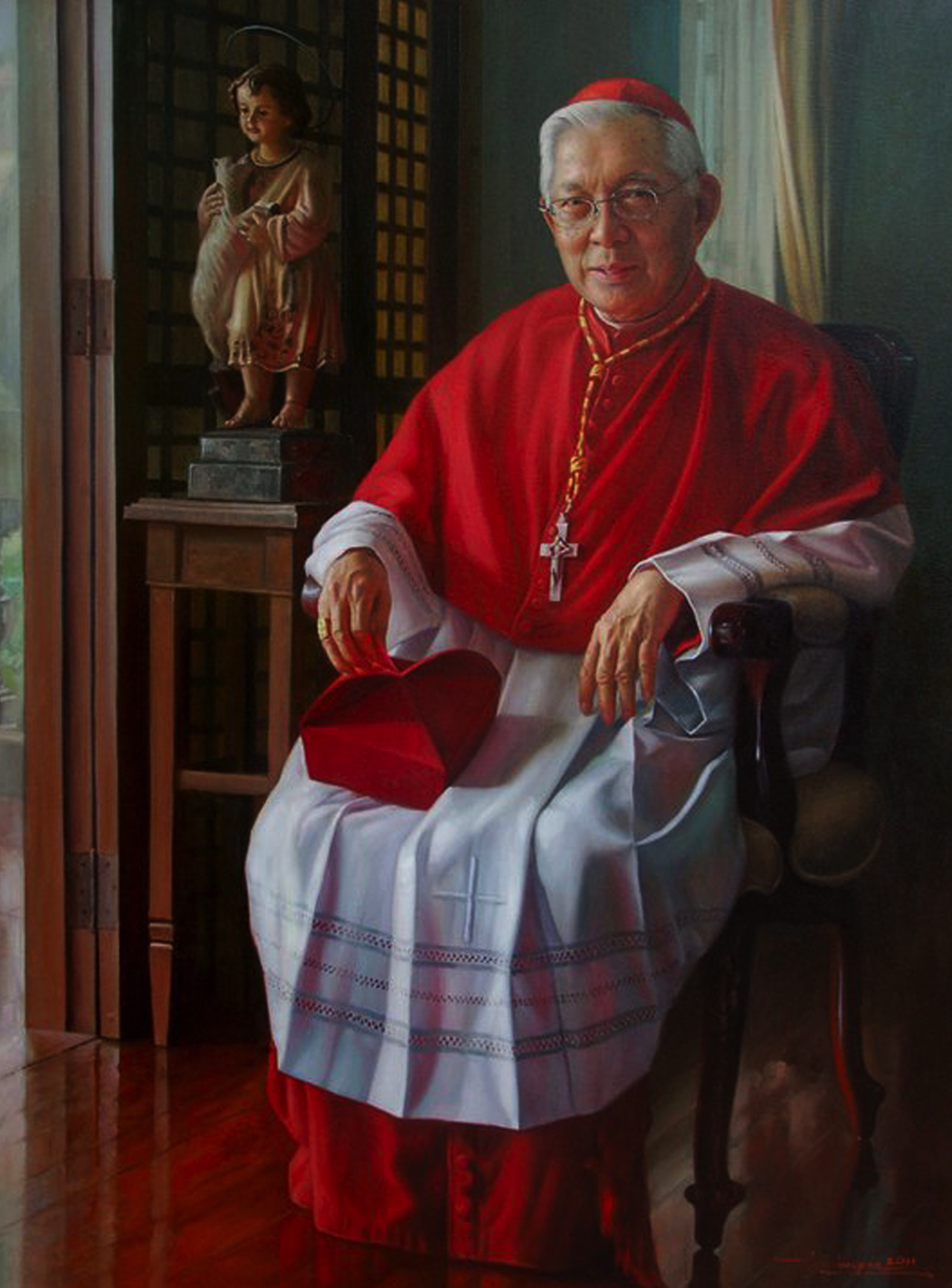
Cardinal Archbishop Emeritus of Manila Gaudencio Borbon Cardinal Rosales
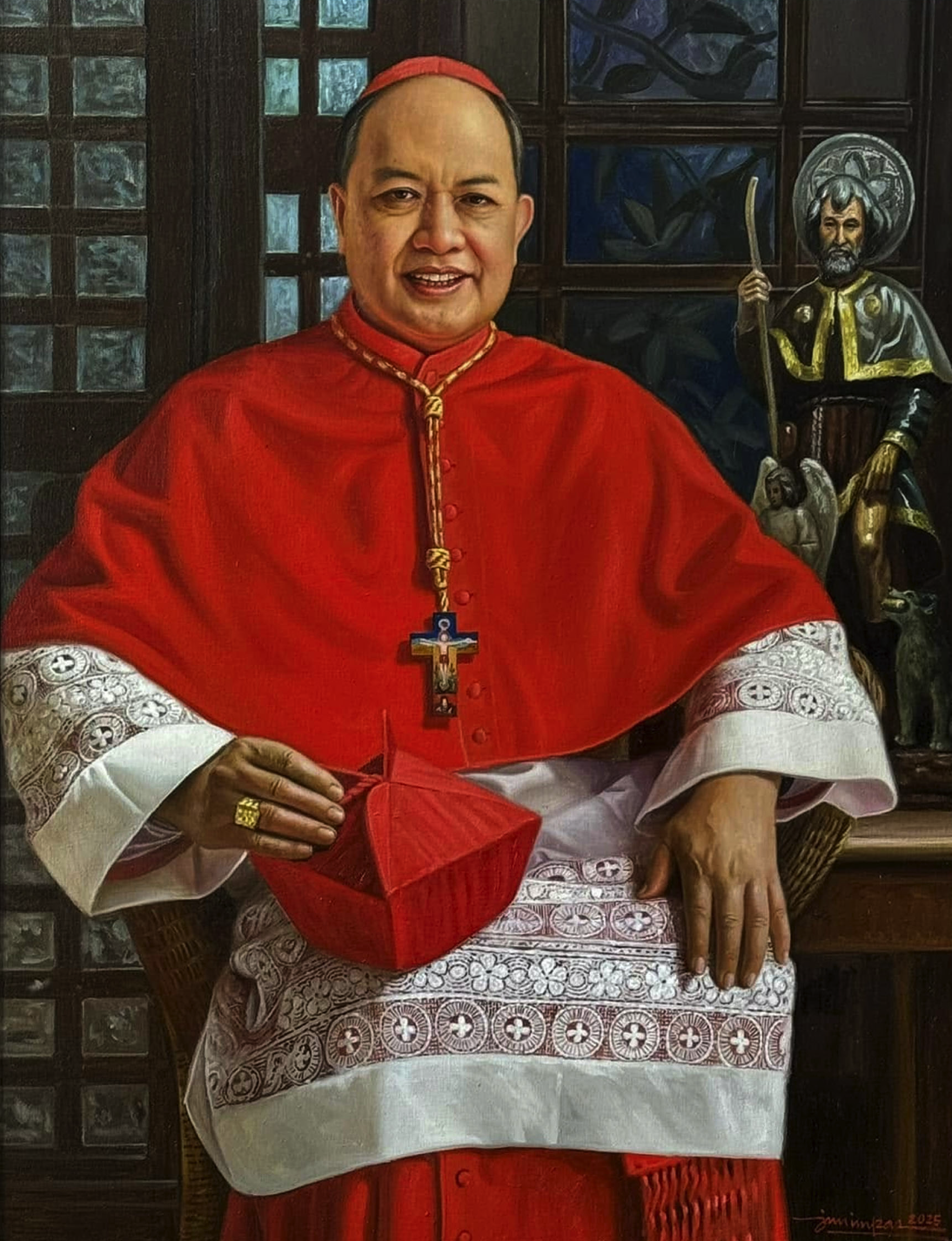
His Eminence Pablo Virgilio David, Cardinal Bishop of Caloocan
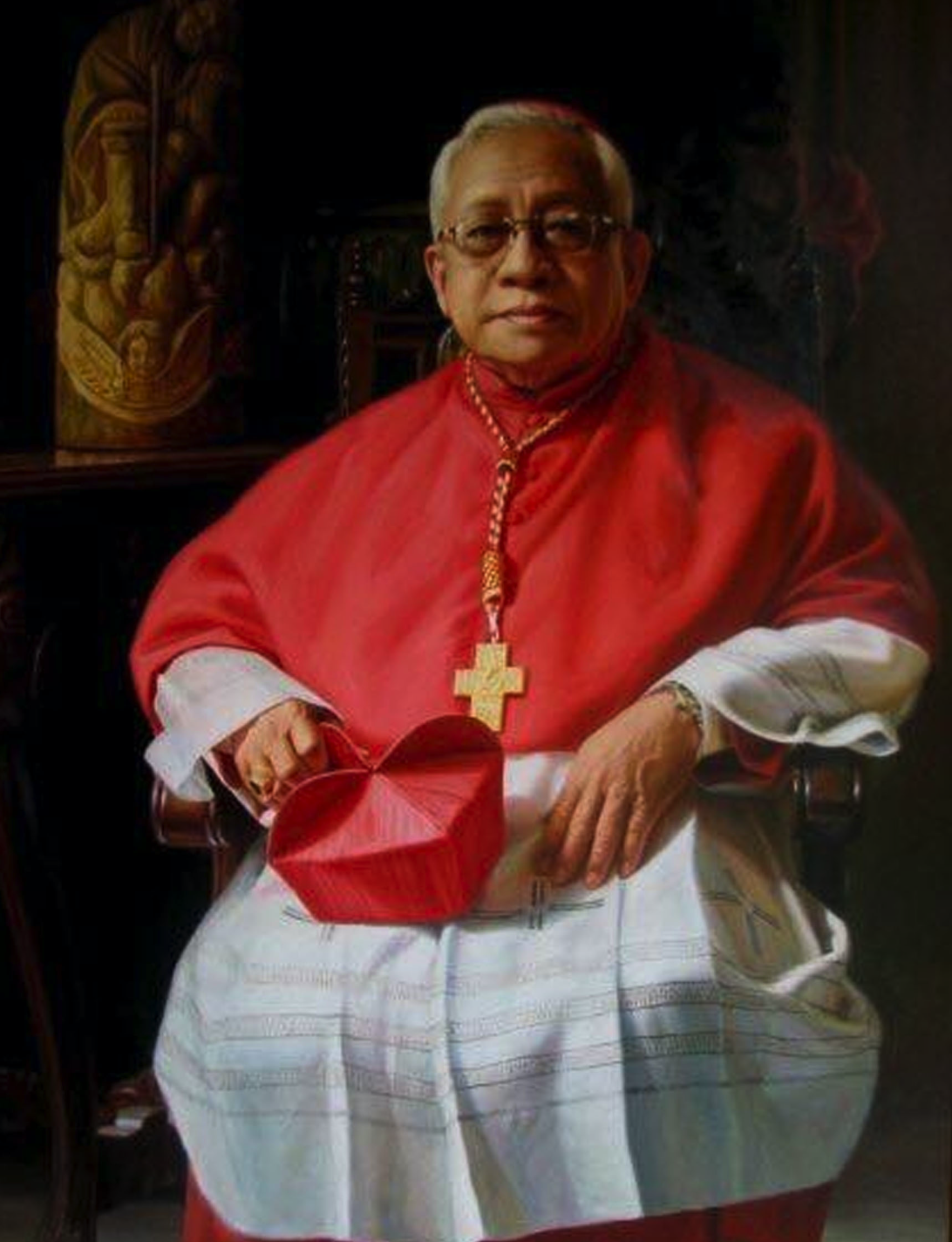
His Eminence Ricardo J. Vidal, Cardinal Archbishop of Cebu
Events
The First NUSTAR BALL
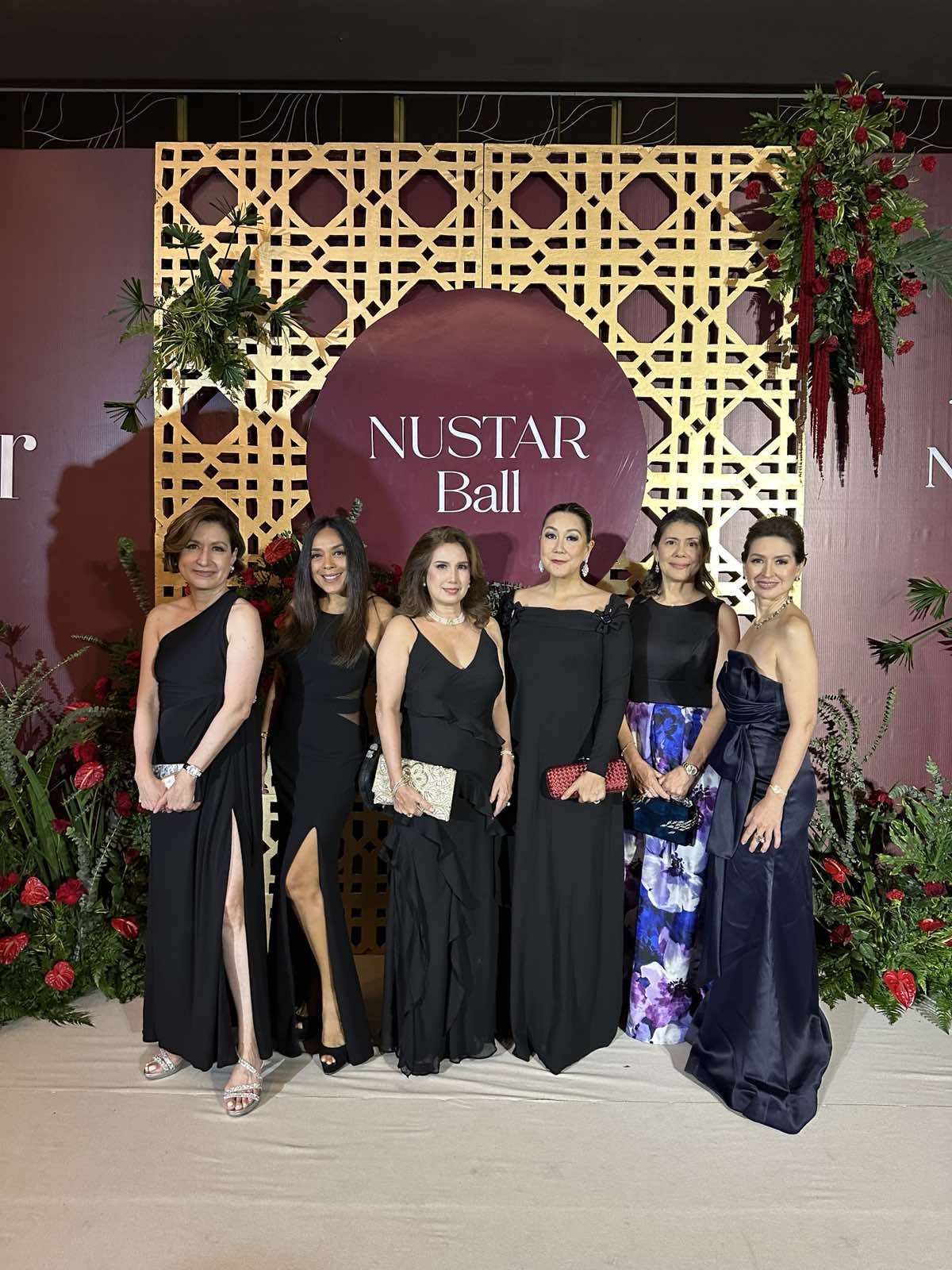
The NUSTAR Ballroom, a magnificent venue at the NUSTAR Resort and Casino in Cebu, sets the stage for last night’s first-ever NUSTAR Ball.

Black was the color of night at the Zee table.
Glamorous guests from Manila and Cebu converged at the NUSTAR Ballroom, an exquisite venue within the NUSTAR Resort and Casino in Cebu. The evening unfolded with a seated 5-course dinner. The opulent feast started with Beetroot Salmon Gravlax, adorned with caper berries, caviar, set with delicate edible flowers; and a main course of Compressed Pork Belly with Crackling Skin and Baby Scallops. Another highlight was the auction of coveted items like Dior and YSL handbags, a limited-edition Bulgari watch, and an exclusive 2-night stay in Nustar’s opulent 3-bedroom villa—complete with a private pool and a dedicated butler. The charity evening benefited the Cameleon Association, an NGO based in Iloilo City created in 1997 that developed a global approach to act on the causes and effects of sexual violence against children.

Nora Sol, Beth Go, Frances Siao and Marylou Ong

Ina Ronquillo, Maryanne Aboitiz and Jackie Lotzof

Designers Jun Escario and Philip Rodriguez

Philip Rodriguez with NUSTAR Malls two power ladies: May Adolfo and Joanna Salazar

Lana Osmeña with Mariquita Yeung

PJ Castillo and Kaye Abad with Cary Santiago

Drew Sarmiento with LV Manager Adrian Decuigan

Cary Santiago with Eva Gullas

Manila socialites Julie Boschi and Ching Cruz with June Alegrado
It was a night of elegance, luxury, and unforgettable memories as ladies in long gowns and gentlemen in black ties danced the night away.
-
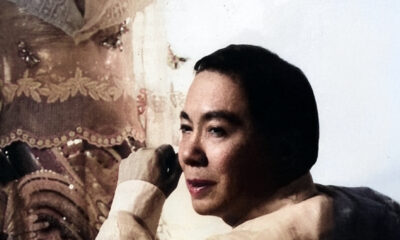
 Arts & Culture3 months ago
Arts & Culture3 months agoAsia’s Fashion Czar I Knew as Tito Pitoy; Remembrance of a Friendship Beyond Fashion with Designer Jose R. Moreno
-
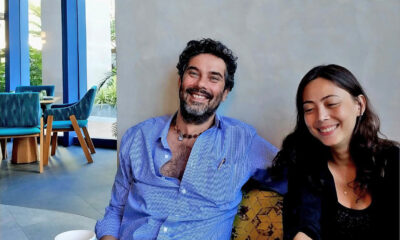
 QuickFx2 months ago
QuickFx2 months agoModern Indian Cuisine; Gagan Sethi and Gwen Trott Spice Things Up at Goa Nights in Cebu
-

 Style1 month ago
Style1 month agoThe Invisible Part of Fashion: Five of the Most Enduring Fragrances of All Times
-

 Arts & Culture2 weeks ago
Arts & Culture2 weeks agoKultura. Kapital. Kasalukuyan: Art that Speaks of Today
-
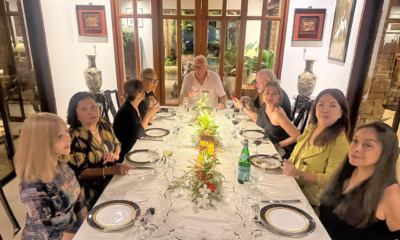
 The Scene1 week ago
The Scene1 week agoAnother Elegant Dinner at Chez Marguerite
-

 Prime Target1 week ago
Prime Target1 week agoLuna Vdl–Endless Summers in Siargao
-

 The Scene3 weeks ago
The Scene3 weeks agoA Stylish Soirée: Cebu’s Elite Celebrate Jackie Deen Lotzoff at Mad Thai
-

 QuickFx4 days ago
QuickFx4 days agoI Lost It at the Movies: Five of the Most Significant Films of the 1960s



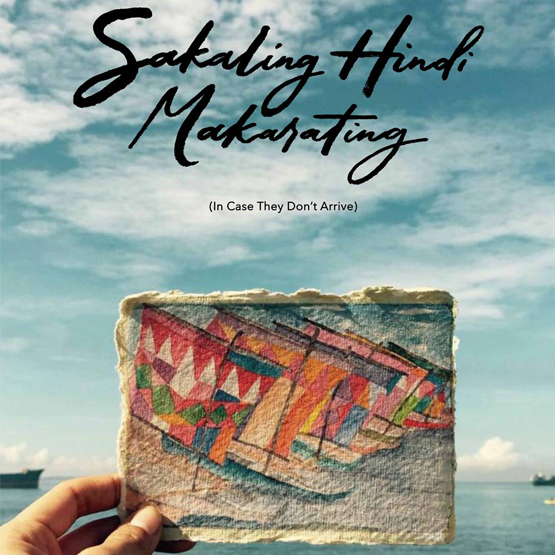





You must be logged in to post a comment Login